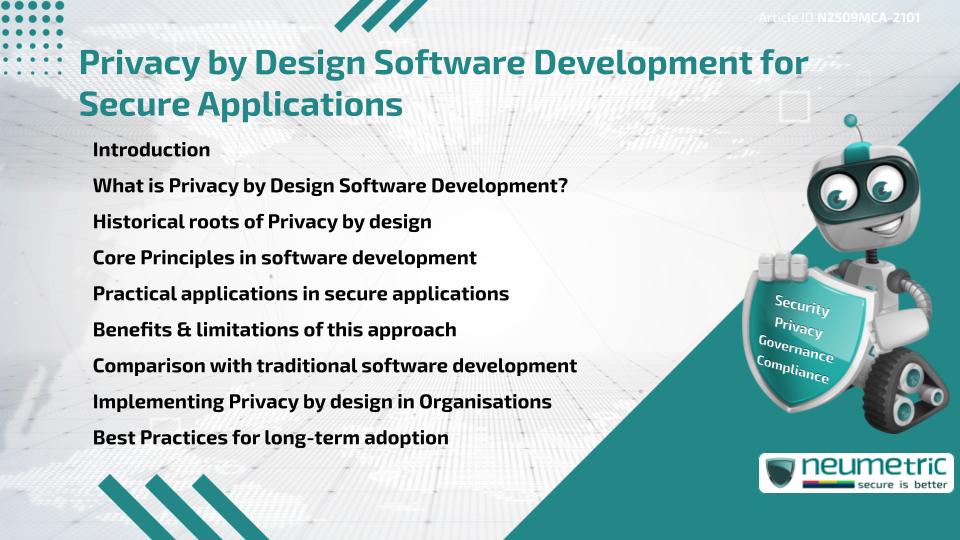Table of Contents
TogglePrivacy by Design Software Development for Secure Applications
Introduction
Privacy by Design Software Development is a methodology that places User Privacy at the core of the software lifecycle. Instead of treating Privacy as an afterthought, this approach integrates safeguards from the planning stage through to deployment. It reduces Risks of data misuse, builds User Trust & ensures Compliance with regulations like the General Data Protection Regulation [GDPR]. By combining Secure coding, User-centric design & Compliance strategies, Privacy by Design Software Development helps Organisations create secure applications that protect Sensitive Information by default.
What is Privacy by Design Software Development?
Privacy by Design Software Development is a proactive approach where Data Protection is not an add-on but an integral part of the software itself. It involves embedding controls like Encryption, Anonymisation & Access Management directly into application architecture. Think of it like constructing a house with strong locks & alarms installed during the build phase, instead of adding them after a break-in.
For secure applications, this means that from the moment developers sketch out system requirements, Privacy features are already woven into the design. This reduces costly retrofits & minimises Vulnerabilities that hackers might exploit.
Historical roots of Privacy by design
The concept of Privacy by design originated in the 1990s through the work of Dr. Ann Cavoukian, then the Information & Privacy Commissioner of Ontario, Canada. She introduced the idea that Privacy should be the default setting in systems & services. Over time, regulators around the world adopted this Framework & today it is explicitly embedded in laws like the GDPR, which mandates “Data Protection by design & by default”.
This historical context shows that Privacy by Design Software Development is not just a technical practice but also a Legal & Ethical responsibility.
Core Principles in software development
The foundation of Privacy by Design Software Development lies in seven Core Principles:
- Proactive not reactive, preventative not remedial
- Privacy as the default setting
- Privacy embedded into design
- Full functionality without trade-offs
- End-to-end Security throughout lifecycle
- Visibility & Transparency
- Respect for User Privacy
These principles guide developers to view Privacy as an enabler of functionality, not as a barrier. When applied in software development, they ensure applications are both Secure & User-friendly.
Practical applications in secure applications
In practice, Privacy by Design Software Development is applied through specific measures:
- Encrypting Sensitive Data both at rest & in transit
- Implementing granular role-based Access Controls
- Using anonymisation or pseudonymisation techniques for Personal Data
- Ensuring Audit trails & Logging mechanisms for Accountability
- Designing interfaces that clearly inform users about data collection
For example, a secure Healthcare application would integrate Patient Data anonymisation during design, making it impossible for unauthorised parties to trace records back to individuals.
Benefits & limitations of this approach
The main benefits of Privacy by Design Software Development include reduced regulatory Risk, higher Customer confidence & long-term cost savings from avoiding data breaches. It also enhances brand reputation as users increasingly prioritise digital trust.
However, limitations exist. Implementing Privacy by design requires investment in training & resources. It may slow down initial development cycles & not all Organisations have the technical maturity to implement it effectively. Critics argue that balancing Privacy with usability can be challenging, especially in data-intensive applications.
Comparison with traditional software development
Traditional software development often leaves Privacy considerations to the end of the process. Developers may only address Data Protection when Compliance checks or Customer feedback highlight Vulnerabilities. This reactive model can result in rushed patches, expensive redesigns & reputational damage.
Privacy by Design Software Development, in contrast, reduces such Risks by making Privacy a structural component of the application itself. It is similar to comparing a car with airbags built into its design versus one where airbags are added later. Both may meet basic safety standards, but the former inspires more trust.
Implementing Privacy by design in Organisations
Organisations that want to adopt Privacy by Design Software Development should start by educating teams on its principles. Collaboration between Developers, Legal teams & Privacy officers is essential.
Steps include:
- Conducting Privacy Impact Assessments at project start
- Defining Privacy requirements alongside functional requirements
- Using frameworks & toolkits for Secure Coding Practices
- Regularly Auditing applications for Compliance
- Establishing clear Accountability structures
Adoption also requires cultural change where Privacy becomes part of organisational values, not just a compliance checkbox.
Best Practices for long-term adoption
Sustaining Privacy by Design Software Development involves Continuous Monitoring & adaptation. Best Practices include:
- Keeping pace with emerging Privacy regulations
- Updating development toolkits with the latest Encryption & Security libraries
- Training staff regularly on evolving Threats & Privacy challenges
- Engaging external Auditors for unbiased assessments
By embedding these practices into their workflows, Organisations ensure their secure applications remain robust against evolving Threats.
Takeaways
- Privacy by Design Software Development integrates Privacy into the earliest stages of the software lifecycle.
- It aligns with regulatory frameworks like the GDPR, making Compliance smoother.
- While it requires upfront investment, it saves costs by reducing data breach Risks.
- Organisations benefit from improved User Trust & Long-term resilience.
FAQ
What is Privacy by Design Software Development?
It is a method of building applications where Privacy features are integrated from the earliest design stages rather than added later.
Why is Privacy by design important for secure applications?
It ensures that sensitive User Data is protected by default, reducing Vulnerabilities & strengthening User Trust.
How does it differ from traditional software development?
Traditional models address Privacy at later stages, while Privacy by design builds it into the structure of the application from the start.
Is Privacy by design required by law?
Yes, frameworks like the GDPR explicitly require Data Protection by design & by default.
What are some examples of Privacy measures in this approach?
Examples include Encryption, anonymisation, role-based Access Controls & Transparent User consent mechanisms.
How can Organisations begin implementing Privacy by design?
They should start with Privacy Impact Assessments, align Functional & Privacy requirements & train Staff on secure coding.
Does Privacy by design apply only to large Organisations?
No, it benefits Organisations of all sizes by ensuring Compliance & building Customer Trust.
Need help for Security, Privacy, Governance & VAPT?
Neumetric provides organisations the necessary help to achieve their Cybersecurity, Compliance, Governance, Privacy, Certifications & Pentesting needs.
Organisations & Businesses, specifically those which provide SaaS & AI Solutions in the Fintech, BFSI & other regulated sectors, usually need a Cybersecurity Partner for meeting & maintaining the ongoing Security & Privacy needs & requirements of their Enterprise Clients & Privacy conscious Customers.
SOC 2, ISO 27001, ISO 42001, NIST, HIPAA, HECVAT, EU GDPR are some of the Frameworks that are served by Fusion – a SaaS, multimodular, multitenant, centralised, automated, Cybersecurity & Compliance Management system.
Neumetric also provides Expert Services for technical security which covers VAPT for Web Applications, APIs, iOS & Android Mobile Apps, Security Testing for AWS & other Cloud Environments & Cloud Infrastructure & other similar scopes.
Reach out to us by Email or filling out the Contact Form…





